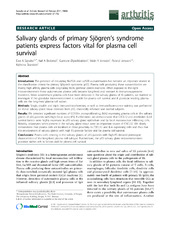| dc.contributor.author | Szyszko, Ewa A. | en_US |
| dc.contributor.author | Brokstad, Karl Albert | en_US |
| dc.contributor.author | Øijordsbakken, Gunnvor | en_US |
| dc.contributor.author | Jonsson, Malin Viktoria | en_US |
| dc.contributor.author | Jonsson, Roland | en_US |
| dc.contributor.author | Skarstein, Kathrine | en_US |
| dc.date.accessioned | 2012-02-07T11:04:52Z | |
| dc.date.available | 2012-02-07T11:04:52Z | |
| dc.date.issued | 2011-01-07 | eng |
| dc.Published | Arthritis Research & Therapy 2011, 13:R2 | en |
| dc.identifier.issn | 1478-6354 | |
| dc.identifier.uri | https://hdl.handle.net/1956/5563 | |
| dc.description.abstract | Introduction: The presence of circulating Ro/SSA and La/SSB autoantibodies has become an important marker in the classification criteria for primary Sjögren’s syndrome (pSS). Plasma cells producing these autoantibodies are mainly high affinity plasma cells originating from germinal centre reactions. When exposed to the right microenvironment these autoimmune plasma cells become long-lived and resistant to immunosuppressive treatment. Since autoimmune plasma cells have been detected in the salivary glands of SS patients, we wanted to investigate if the glandular microenvironment is suitable for plasma cell survival and if glandular residing plasma cells are the long-lived plasma cell subset. Methods: Single, double and triple immunohistochemistry as well as immunofluorescence staining was performed on minor salivary gland tissue retrieved from pSS, chronically inflamed and normal subjects. Results: We detected significant numbers of CD138+, non-proliferating, Bcl-2 expressing plasma cells in the salivary glands of pSS patients with high focus score (FS). Furthermore, we demonstrated that CXCL12 and interleukin (IL)-6 survival factors were highly expressed in pSS salivary gland epithelium and by focal mononuclear infiltrating cells. Notably, adipocytes when present in the salivary gland tissue were an important source of CXCL12. We clearly demonstrate that plasma cells are localised in close proximity to CXCL12 and IL-6 expressing cells and thus that the environment of salivary glands with high FS provide factors vital for plasma cell survival. Conclusions: Plasma cells residing in the salivary glands of pSS patients with high FS showed phenotypic characteristics of the long-lived plasma cell subtype. Furthermore, the pSS salivary gland microenvironment provided niches rich in factors vital for plasma cell survival. | en_US |
| dc.language.iso | eng | eng |
| dc.publisher | BioMed Central | eng |
| dc.rights | Attribution CC BY | eng |
| dc.rights.uri | http://creativecommons.org/licenses/by/2.0/ | eng |
| dc.title | Salivary glands of primary Sjögren’s syndrome patients express factors vital for plasma cell survival | en_US |
| dc.type | Peer reviewed | |
| dc.type | Journal article | |
| dc.description.version | publishedVersion | en_US |
| dc.rights.holder | Copyright 2011 Szyszko et al.; licensee BioMed Central Ltd. | |
| dc.identifier.doi | https://doi.org/10.1186/ar3220 | |
| dc.identifier.cristin | 842602 | |
| dc.subject.nsi | VDP::Mathematics and natural science: 400::Basic biosciences: 470::Cell biology: 471 | eng |

